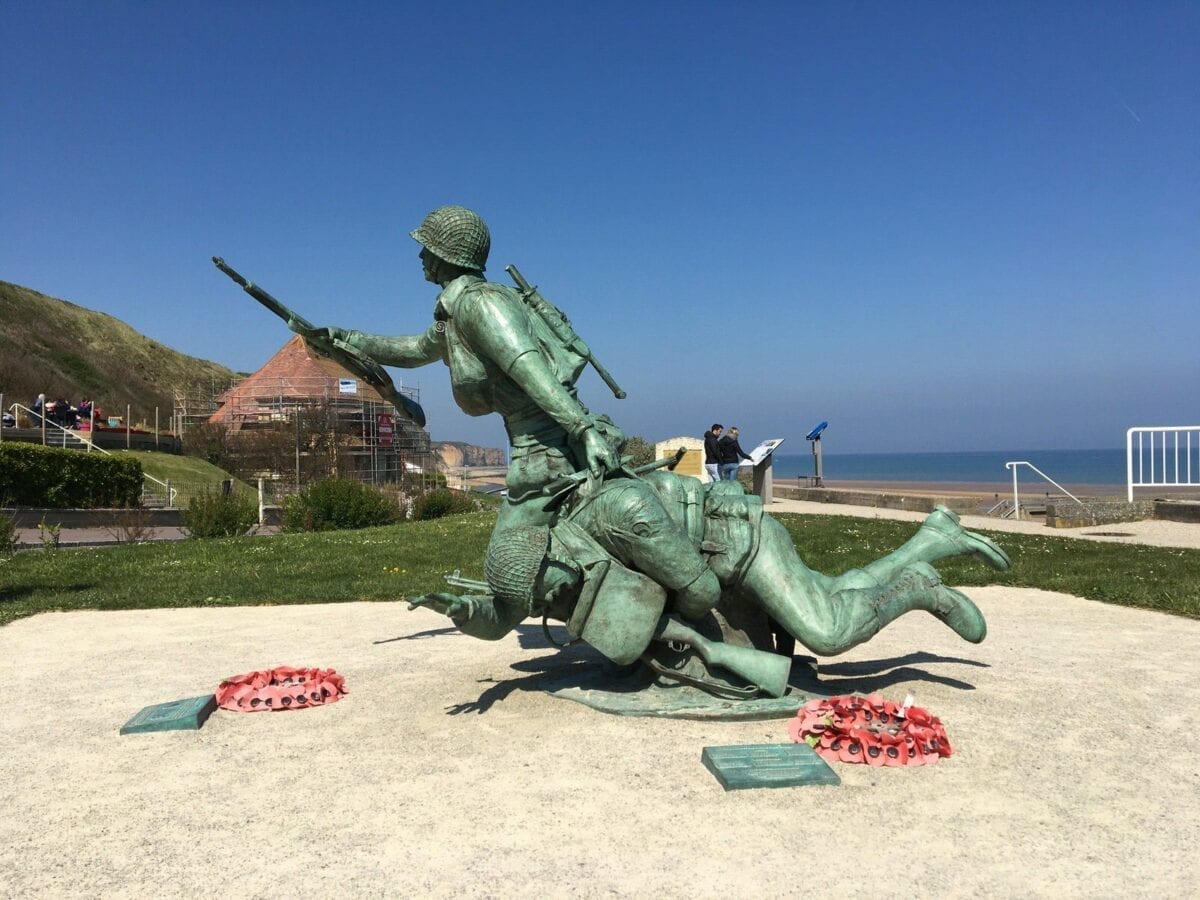It�s hard to imagine a world where Gurren Lagann and Kill la Kill don�t exist in the greater anime landscape. The two titles were fueled by a brash, bold energy that demanded and commanded audiences� attention, in equal measure...
It�s hard to imagine a world where Gurren Lagann and Kill la Kill don�t exist in the greater anime landscape. The two titles were fueled by a brash, bold energy that demanded and commanded audiences� attention, in equal measure and helped cement director Hiroyuki Imaishi as a leading figure in the evolving anime industry landscape.
This year marks the tenth anniversary of Studio Trigger�s Kill la Kill, and the fifteenth anniversary of the first Gurren Lagann film, Gurren Lagann the Movie: Childhood�s End. To celebrate the occasion, Aniplex of America prepared a star-studded event in Anime NYC�s cavernous Hall 1D. The capacity crowd erupted in cheers, as the Kill la Kill theme song Sirius by Eir Aoi kicked in over the room�s sound system, and the show�s opening segment began to play on the massive monitor at the center of the auditorium.
As the music died down, panelists Alexandria Hill and Anthony Foronda greeted the room. They began with short announcements that Kill la Kill merchandise was available in the dealer�s room, before introducing the event�s guests of honor.
One by one, director Hiroyuki Imaishi, creative officer Hiromi Wakabayashi, and designer Shigeto Koyama took the stage, as the audience roared with whoops and applause. After a brief greeting, Hill and Foronda shifted the conversation to Kill la Kill.
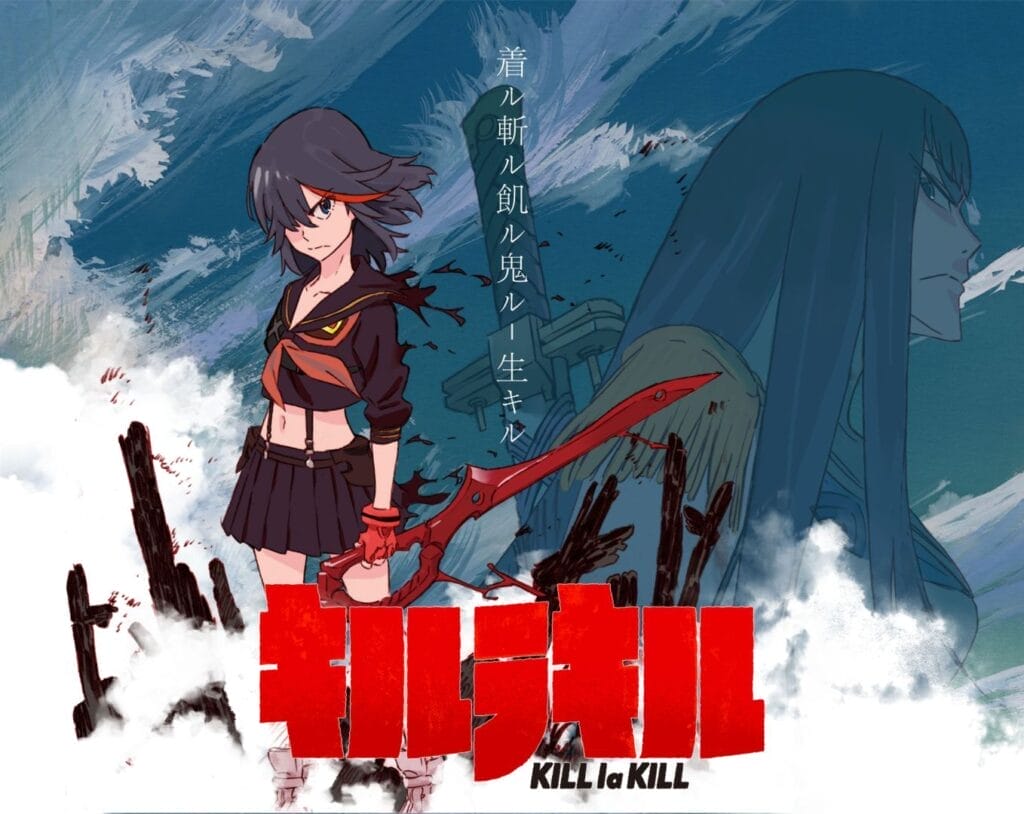
How did Kill la Kill come to be?
Imaishi leaned into the microphone. �So, when I was getting into Kill la Kill�s project, we just got out of Gurren Lagann,� he began. Imaishi continued, explaining that he entered the project under heavy pressure and that they were struggling in their current direction. Rather than continue forward, he instead decided to scrap everything and just try to have fun, �and that�s when everything started to come together.�
Wakabayashi confirmed Imaishi�s comments, stating that �Kill la Kill was Studio Trigger�s first television project, and the pressure was quite big; we couldn�t screw it up.� The team instead made their primary goal to have fun, as they poured everything they enjoyed into the series.
Koyama paused for a moment, thinking, before responding. �When Kill la Kill was getting going,� he began, �Studio Trigger wasn�t a proper studio at that point. They had a small rental space and that was where we were having our meetings. So, the initial concept was very broad, and we only had something about students in uniforms, fighting. But we�re too used to having mechs in our show, so it was too difficult. And there was this one moment where Imaishi proposed, �How about we mix bondage and school uniforms?� That�s when my engine sparked! This was, you know� it just came out of nowhere, and this spark of brilliance came from our director, and I hope you understand just how creative our director is!�
What is your role as Creative Officer and what were your duties on Kill la Kill?
Wakabayashi took a moment to think, before explaining that the role of Creative Officer was given to him exclusively for Kill la Kill. Specifically, Koyama bestowed the title upon him as, during meetings, Wakabayashi gave him a hard time.
Or, more bluntly, he we merciless when critiquing Koyama�s designs. In response, �Koyama said, �If he�s going to give that much feedback on designs, they should call him a creative officer!��
The audience chuckled at the anecdote, as Koyama elaborated. He explained that, while Wakabayashi was the youngest staffer on the project, he was also the quickest to criticize the team�s designs, something that could only really be done at Trigger at the time due to the company�s structure. �So, yeah. The director would come up with a design and he would say �looks like crap!��
Koyama continued, noting that Wakabayashi would easily deny him from doing what he wanted to do. �So, yeah, during the meetings, he�d point out points on the characters and say, �You know it�d be better if you fixed the characters here.��
What did you and your team consider to be the most valuable methods when going into production of Kill la Kill?
Imaishi pondered for a moment, before leaning forward once more to describe one of the series� visual feats, �So, this is quite normal in today�s industry,� he began, �but Kill la Kill was about ten years ago. And back then, this method that I wanted to implement was very unusual, or fresh in the industry. And what I paid extreme attention to was to implement a hand-drawn-esque [style of] lighting and smoke to the camera.�
He continued, explaining that he and series writer Kazuki Nakashima grew up with manga and anime from the Showa Era. The two sought to replicate the retro touch, the vibe of which character designer Sushio was able to capture through the use of heavy, bold linework. �And another point,� he added, �was to use the text as a prop in this show. This gradually escalated over several episodes, but fonts would get bigger and bolder, to the point where the characters can even interact with these fonts.�
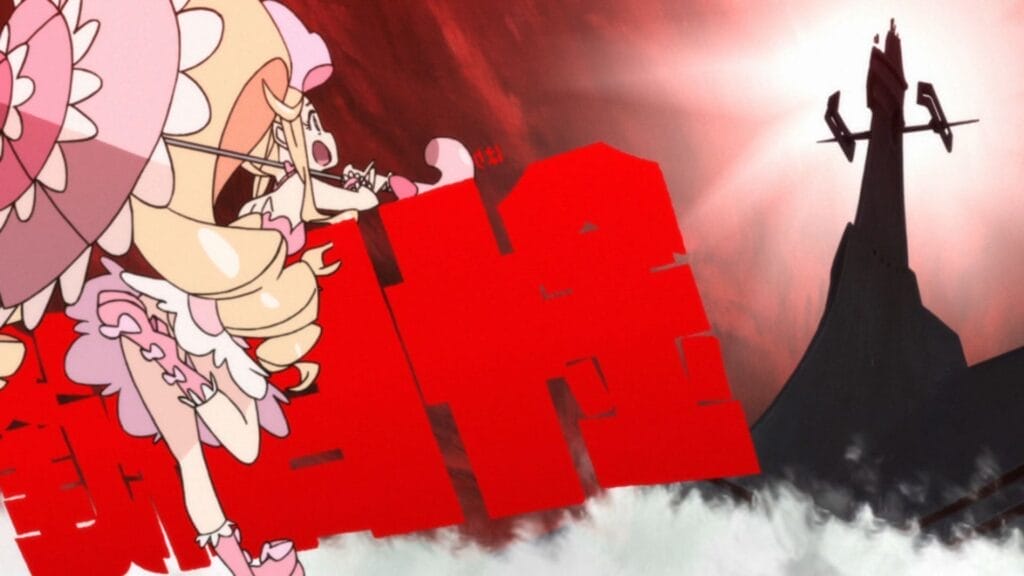
Could you talk about the inspirations that influenced your color palette choices?
Koyama cleared his throat before he began. �So again,� he noted, �Kill la Kill was the first project for Studio Trigger, but I also wanted our audience to know we came from Gainax working on Gurren Lagann. So, if I were to give an example, for example [in] Gundam, the good guys are generally white [�] and the bad guys are generally darker or black colored.�
For Gurren Lagann, the team sought to invert the visual language that was set by its forebears in the mecha genre. �[�] in Gurren Lagann, the main protagonists are colored more darker, and the enemies are generally light.� This motif continued going into Kill la Kill, in which � � the protagonist has a darker profile, while the enemies or Elite Four have this generally light color.� He noted that this was an aspect which he paid particular attention to.
As Koyama answered, and the audience applauded politely, Hill and Foronda announced that two more people would join for the next section. The room erupted in rapturous cheers, as Ryuko dub actor Erica Mendez an Mako dub actor Christine Marie Cabanos took the stage. The two delivered iconic character lines, to pops of applause, before introducing themselves.
Can you describe your audition process and what it was like meeting the characters for the first time?
Mendez answered first, recalling that �I remember getting the audition and remembering that Ryuko was the coolest character I had seen in a long time.� She was originally brought into the studio for a different role, and they had her read on Ryuko. �The next thing I knew, we had gone through the whole first episode.� She added that Ryuko was her first really big role, and that it was �very big and very exciting.�
Cabanos recalled that she heard about Kill la Kill, and that English adaptation director Alex Von David told her, �I have a character in mind for you!� She added that she connected with Mako naturally, remarking that she �was like my soulmate!�
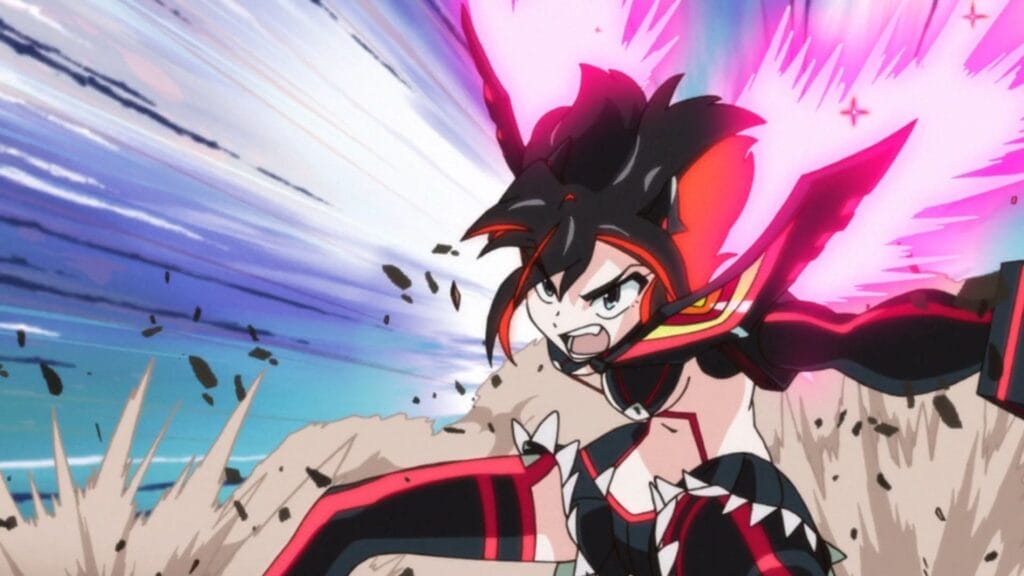
Can you describe voicing Ryuko, and how it impacted your career?
Mendez paused for a moment, before remarking that she enjoyed Ryuko�s journey, and that she can hear herself growing as an actor through the series. She joked that she learned that she could scream.
But, beyond that, Ryuko taught her to �be brave and more outgoing,� so the character was especially important to her.
What influenced your portrayal of Mako, and how has voicing her impacted your career to this day?
Cabanos was chipper,as she stated that �Mako is like me amped up to eleven.� She elaborated, saying that playing Mako was liberating, as the show�s over-the-top tone allowed her to be as crazy and wild as possible. She added that the experience was cathartic, and taught her that she could reach for the stars.

Can you share your thoughts on your shows getting English dubs?
Wakabayashi remarked that he was happy to see series presented in English, and praised the dubs for being �powered up with enthusiasm.�
Imaishi, meanwhile, noted that he�s glad that Kamui Senketsu kept his namesake in the English adaptation.
How did Imaishi�s creativity influence your performance?
Mendez was first to respond, stating �I just fell in love with the way the characters move and the characters interact with each other and the colors.� She remarked that she could see how the characters lived, which made it easier for her, as an actor to breathe life into the role.
Cabanos remarked that the animation and art style �make it hard not to be happy.� The dynamic nature of the characters made it easier to get into their heads and bring them to life. She quipped, �they already did half the work!�
Following their answers, Mendez and Cabanos each presented the staff with a question of their own.
Erica Mendez: �Based on how the name Kill la Kill is said in Japanese, I hear it�s a play on words that means �to wear�, so how did you go about naming this title?�
Imaishi thought for a moment, before answering. The title was something that he and Kazuki Nakashima had pondered for a while. Ultimately, Nakashima came up with the term, as the term kiru has three distinct meanings in Japanese:
??, which means �to wear clothes� ??, which means �to cut or lacerate� ??, which means �to kill someone.�He offered kudos to Nakashima-sensei for creating the three-layered play on words the title presents.
Christine Cabanos: Who is Mako�s romantic interest? Ryuko or Ira Gamogoori?
Imaishi paused once more, before responding. �I get this a lot from our fans, as well,� he noted, �but what it ultimately boils down to is we only have control over what happens in the series � what�s present on-screen. So, if it�s not said verbally or in action, the rest is up to your imaginations!�
How would you describe Kill la Kill in one word?
Imaishi responded first, stating, �So this is, I guess a comment I can make as a creator, but I really went overboard! So, on every project since Kill la Kill, I always tell myself to not push it too much.�
Wakabayashi thought for a moment, before answering. �If I were to describe it in one word,� he began, �it would be �thorns� or �edges�. As you can see, there are a lot of pointy objects on a lot of uniforms, and the content of Kill la Kill is quite edgy. And, you know, they�re so pointy that when we were working on Kill la Kill, I was also hurting myself while working on it.�
Koyama smiled devilishly as he leaned toward the microphone. �This is a very difficult question, but if I were to choose one word, it would probably be Sushio!� He likened Kill la Kill�s character designer to �a barebones F1 racing machine that has no safety mechanism, whatsoever. [�] But he really fits what Kill la Kill is!� He added that �I knew he would be a great fit for this project.� Koyama let out a small chuckle as he continued, stating �And due to that, it was a pretty rough project to work on, but you all witnessed the results, right?�
Mendez commented next, stating �I�m a very visual person, and I�ve always admired the colors that the show has in it; there�s so many of them. So mine would probably be �colorful��
Cabanos grinned as she delivered her answer. ��At the risk of going Mako Mankanshoku,� she began, �I would like to submit �runaway train� as one word!�
As the Kil la Kill segment drew to a close, Mendez and Cabanos offered their closing remarks. �Thank you to all the fans for watching the show,� Mendez said with a beaming smile. �And thank you to Imaishi-san and Trigger for making the show, because we all saw this show and we knew it was something special.�
Mendez followed up, saying �As Christine said, thank you to Imashi-san, to Trigger, Alex [Von David] and David [Vincent], and the production team.� She added that, to this day, she meets people who tell her about how Kill la Kill got them into anime, or back into anime, and that it still holds up. She couldn�t have begun to imagine that she�d work on a show that, a decade later, would have such a hold on peoples� hearts and minds. And for that, Kill la Kill will always hold a special place in her heart.
The audience erupted in cheers, as Menzed and Cabanos excused themselves from the stage. The slides shifted once more, to key art for Gurren Lagann the Movie: Childhood�s End. The Aniplex team opened the segment by announcing that they would be publishing a re-release of both films on home video, before breaking into a question-and-answer session.
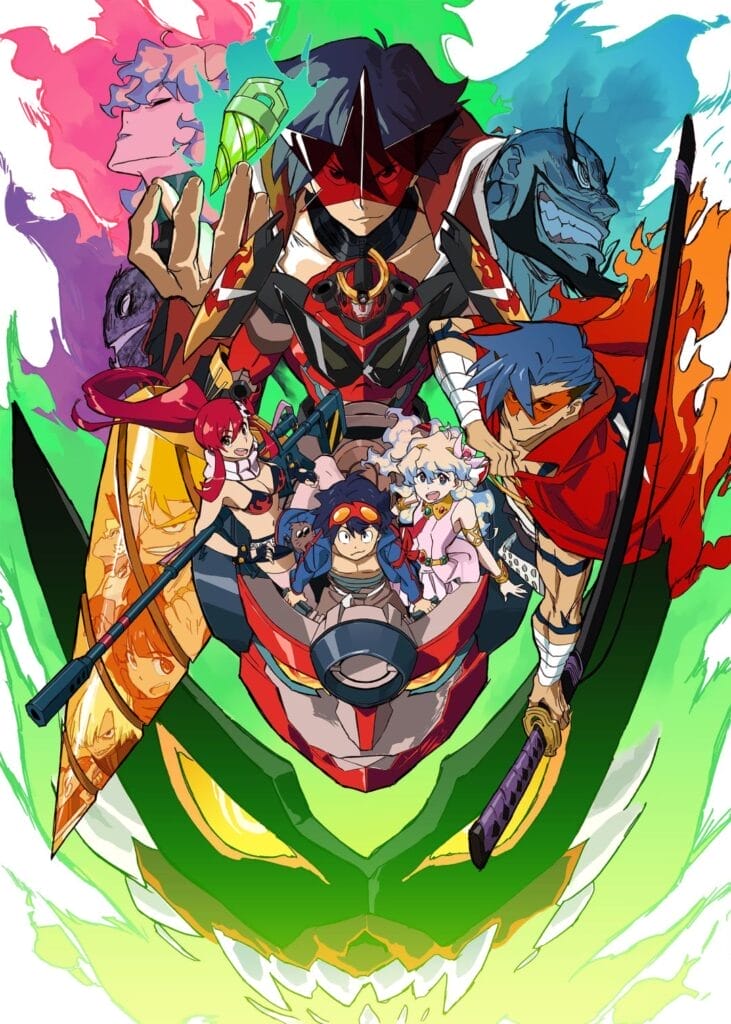
What is it like, looking back on Gurren Lagann?
Imaishi explained that Gurren Lagann is even older than Kill la Kill and, while reviewing the 2008 film, he recognized his younger self in it. �I was so full of energy and mistakes; I�m confident in saying that I would not be able to make Gurren Lagann if I were to try today.�
What was your role on the series, and can you tell us about a time when you were able to demonstrate your creativity on Gurren Lagann?
Koyama shifted his position and relaxed as he started speaking. �I guess my impression is that [�] the workload was immense. And back in the days, the Japanese anime industry was� all-nighers were still accepted. So back in the day, again, the studio was sort of a sleepless facility. Even in the series, for Gurren Lagann. In the later half of the series, there�s a time gap [�] and as the story progresses, the characters are [�] they are endangered by the situation, I suppose. And I felt a resemblance to the creative team because the deadline was also nearing.�
According to Koyama, the team would have boot camp-type excursions, where they would go somewhere for two days, and come up with a design within the timeframe. He chuckled as he added, �So, Simon was also in great danger, schedule-wise as well!�
These boot camps did pay off, though, as the team exited them with large amounts of reference materials. �The amount of reference materials and assets involved in the production of Gurren Lagann is just about three times, triple the amount of a regular anime series,� he explained. �So when I was making Gurren Lagann, I was pondering why any other production team doesn�t do this. If we put in the effort, it�s bound to be more interesting. After making Gurren Lagann, I understand why people try to optimize these procedures.�
Can you talk a little bit about where the idea of using image boards during the production of Gurren Lagann came from?
Imaishi leaned toward the microphone as he answered. �So, I would like to mention that image board was a thing in the [greater film] industry, but it was just not that prevalent in the Japanese industry. And I would be reviewing art books by these American studios, and I was always envious of those, so I decided to implement image boards on Gurren Lagann, as well.�
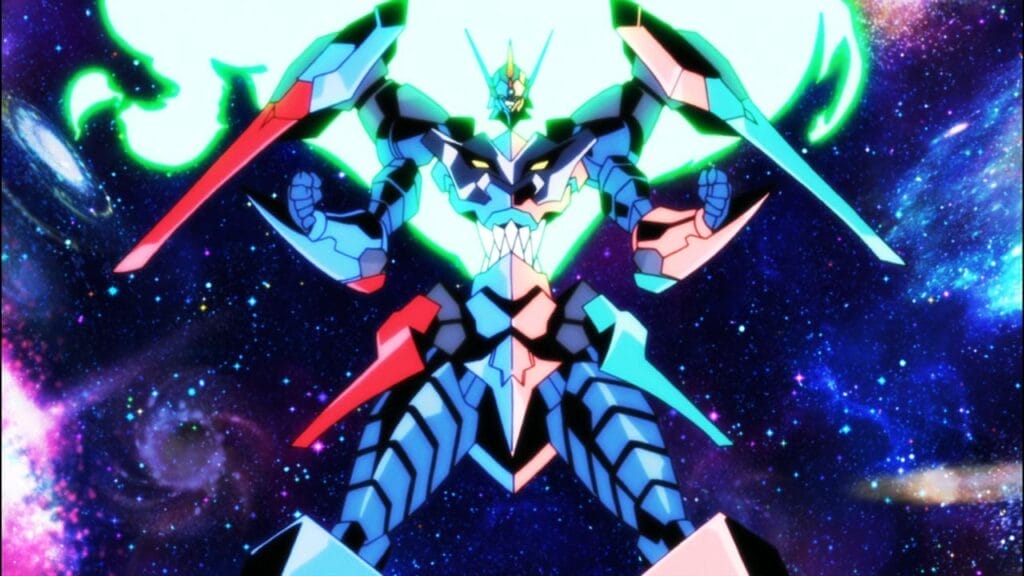
What is your approach to imaging the iconic battles for the movies? Do you have any favorites?�
Imaishi remarked, �There is a part of me that takes on these projects, so I can do these battle scenes, so I try not to think too deeply into this topic.� For Childhood�s End, he noted that he �had a lot of budget to work on the action scenes,� more than he could ever have had allocated to a television series, so he was pleased with the overall quality of the film�s action scenes and artwork.
What is a good mecha design to you?
Imaishi was the first to respond. �So, for Gurren Lagann,� he began, �I�d like to think of the mechs as an extension to the characters who ride or control the mech. That is what I value most.�
Wakabayashi took a moment to consider his answer. �So what I value most in these designs are not just aesthetics,� he explained, �but how cool, or how nice they are perceived within the drama or the story of the series. For, example, I believe a lot of folks think Lagann looks unusual initially. But over the course of the series, it grows on you and though it has a very cute aesthetic, it�s almost like a comrade.�
Koyama took a more philosophical approach to the question, remarking that �A lot of folks say mechs, but anime itself is like a fantasy, in a sort of way.� According to him, �mechs should be a character, as well.� He used Star Wars as an example, explaining that �Luke Skywalker�s X-Wing, to me, looks like a white horse or a white steed, and the Millennium Falcon looks like a cute turtle to me!�
In this light, he argued that �mechs should be� as least, I treat the mechs as a character. And in Gurren Lagann, all of the mechs have a face, so they�re characterized as a character in the series.� He challenged viewers to rewatch the show, as he pointed out �a lot of these vehicles and mechs do have a face on them, so it might be a good idea to go through the series and see how many have a face.�
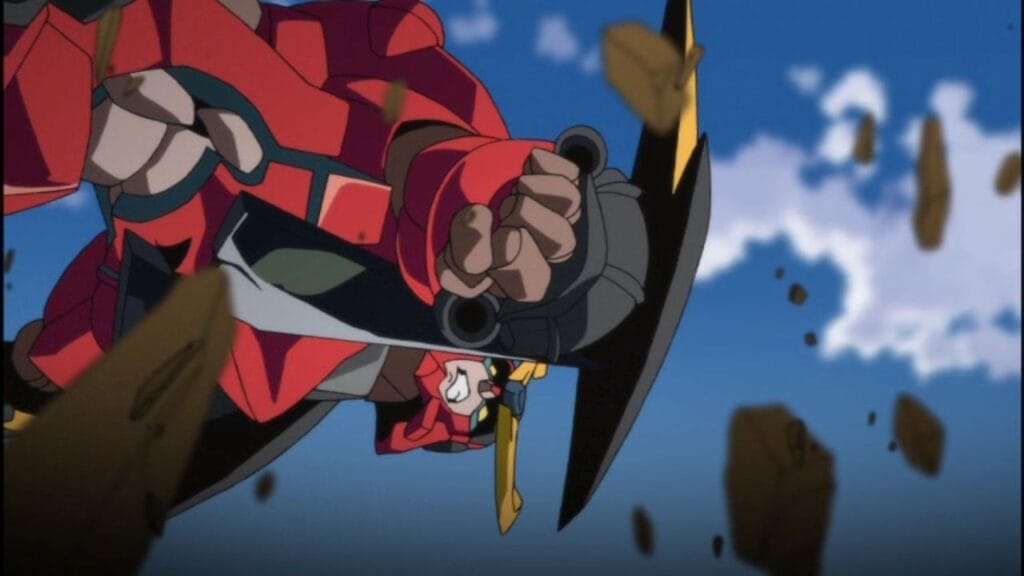
Could you tell us about mecha facial expressions in the series? Do they feel, or is it an extension of the pilot?
Imaishi made the first response once more. �Technically, they are robots or mechs, so they shouldn�t feel pain or whatnot.� He added that �the facial expressions are just a result of my direction, I suppose. It�s trying to make the scene look a bit better. But as Koyama said, we treat these mechs like a character, and as the episodes went on, it wasn�t something I really thought about.�
He paused for a moment, before continuing. �So, I do believe that it is an intentional decision. Like, in the super robot genre, the mechs are generally an extension of the pilot or whoever controls the mech.�
What was it about the super robot genre that made you and the team want to revisit this type of storytelling?
Wakabayashi led off, explaining that Gurren Lagann contained much of the �essence� of shows that Imaishi and Kazuki Nakashima watched while growing up.
Imaishi elaborated, noting that �[�] a lot of the robot series that I grew up watching had a lot of this exciting essence, but around the time Gurren Lagann was released, the trend was toward a more realistic robot series. And the more I think about the genre of robot series, it�s really impractical!�
This proved liberating for the director, who explained, �[�] a humanoid robot looking robot that is larger than a building? It just makes no sense, right? So to make it make sense, I felt like the surrounding world also needs to be a little bit stylized, I supposed. And, by doing that, I am able to include this comedic relief, as well.�
The audience applauded politely, as Hill and Foronda introduced a number of messages that were submitted ahead of the event. Once finished, they noted that there was just one last thing to show off.
The lights grew dim, and the crowd erupted in cheers as the video screens began rolling a pre-recorded message from Kamina actor Katsuyuki Konishi. Konishi was vibrant and perky, as he greeted the audience, and expressed his regret over not being able to attend, before breaking into a conversation with the camera about Gurren Lagann, and his experiences with the series. He turned his back to the camera, to reveal that he still had, and was actually wearing the Kamina cape that he had donned in 2010 when he attended Anime Expo.
As time grew short, Konishi eagerly announced that he had some �very special news� to share. He revealed that the Gurren Lagann movies would receive a theatrical run in January 2024, with shiny new 4K masters and 4D enhancements.
The audience cheered as he signed off, and Foronda confirmed that the Childhood�s End would hit cinemas on January 16 and 17, and Lights in the Sky are Stars would open a week later, on January 23 and 24. Furthermore, in addition to the new masters, the films would receive an English dub for the very first time.
The Aniplex team had one final surprise for the audience, who had erupted in cheers once more. The company would be releasing a BUZZmod figure of Gurren Lagann�s Yoko Littner. Wakabayashi grinned as he quipped that �Even the boobs move,� when pointing out how many joints were in the figure.
With the day�s announcements complete, the room applauded and cheered once again, as wave after wave of fans swept back into the halls of the Javits Center. It was an unforgettable experience, in which that packed auditorium was able to get one glimpse into the minds of giants who helped define, and redefine anime in the modern era time and time again.
Anime NYC 2023: Aniplex of America Presents the Kill la Kill x Gurren Lagann Anniversary Event - Samantha Ferreira






